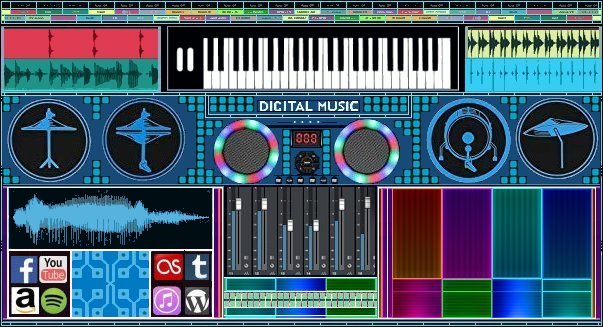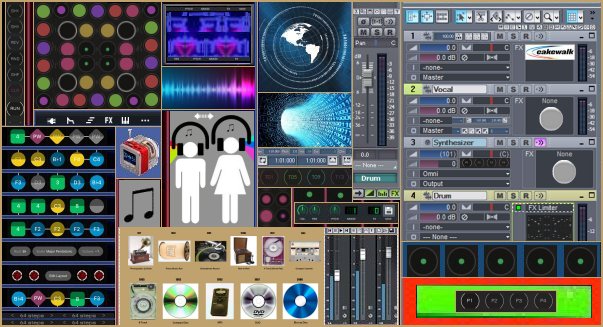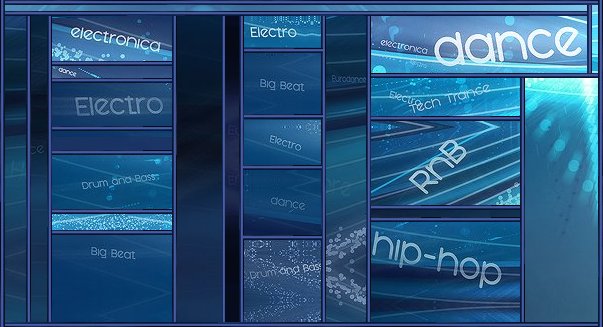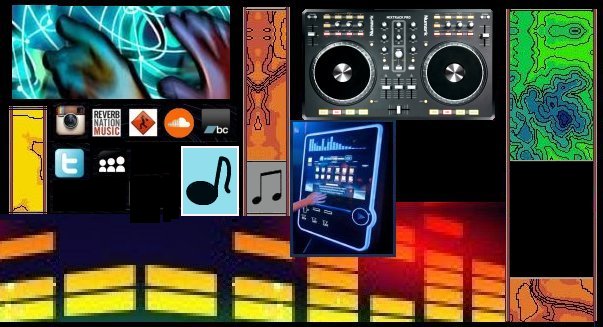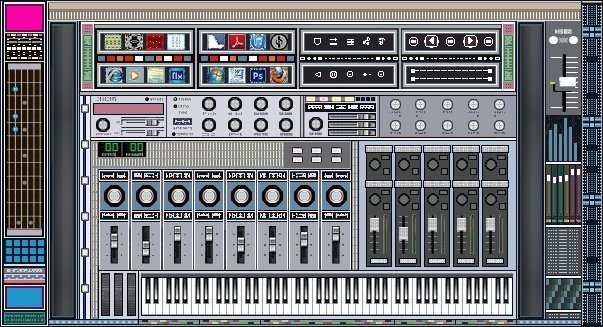
Up to 1983 we lived in a digital-audio-free world where the music industry prospered in analogue monopoly. The nineties proved fatal for everybody in the music industry as analogue was replaced by digital supremacy; traditional distribution channels were replaced by online distribution channels.
The evolution of music stretches from the middle of the twentieth century (1950s) to the present time in the twenty-first century (2020s). Although music genres have developed over the decades and talented artists, musicians, and bands have impacted music in multiple ways, music has advanced mostly due to technological improvements which have permanently transformed the music industry and the way music is created, marketed, and consumed. In the digital era music is no longer recorded but programmed. Cassettes have been replaced by CDs and MP3 files as well as CD-Rs (on which to write [create] digital music in wave
or MP3 format on a computer). It has become a world of instruments and engineers which has provided musicians with a new set of innovative opportunities. If a musician can play a synthesiser and create beats, studying how to distribute digital music is the easiest step in the entire process. The most important global marketing technique is via digital music distribution. There are numerous global digital music distribution stores that sell music online; the favourite ones are Spotify, Apple Music, iTunes, and Amazon Music. Electronic music on a computer is produced with a Digital Audio Workstation; a DAW is a software application that produces, edits, and records music (examples of popular DAW software is Cakewalk, Cubase, and FL Studio). A brief summary of how to generate a digital song on the computer is to open the DAW software, create a new song file, set the beats per minute (BPM) to fit the song’s tempo, and lay down a repetitive bass of percussion instruments.
Archaeologists and anthropologists have theorised about the cultural development of music and have come to the conclusion that music is expressed through chronological cultural evolutions. An intriguing extension of cognitive science would be research related to culture, language, and the evolution of music. Acoustics, anthropology, biology, ethnomusicology, and psychology should be combined to study music as a global cultural phenomenon. All creatures and cultures are part and parcel of the origin, presence, and development of music; it is a fundamental part of life and the language everybody understands. Birds and other animals produce sounds to communicate with each other. Humans have been exposed to music centuries ago. Tribal dances have led to the origins of prehistoric ‘drumming and rhythm’ inventions of sticks and stones to accompany chanting and singing. The earliest melody-type instruments discovered by archaeologists date from the Palaeolithic period and are simple flutes and whistles carved from animal bones and wood. These instruments are believed to be among the most primitive prehistoric instruments. An instrument named the tjurunga even dates back further into history. Since its creation, music can be divided into different eras that have developed into separate genres (music styles) with sub-styles under each genre. Without going into a long discussion about the history and revolution of each genre and sub-genre it is important to highlight specific historical events.
Popular music is characterised by a series of separate eras which created genres such as country, rhythm and blues (RNB), and rock and roll with sub-genres under each category (divided by individual revolutions). The American pop culture during the fifties and sixties influenced the evolution of rock and roll music. The sixties brought many firsts, from the first music video to the considerable progress of racial integration in music. The music and festivals of the Caribbean islands created a rich cultural history that greatly influenced European and American music. Several music genres originated on these islands which included traditional Puerto Rican aguinaldo, the Jamaican mento, reggae, and salsa. Mento (Jamaican folk music) is a blend of European and African rhythmic components. This music style mostly influenced reggae, and ska (a combination of Caribbean and Jamaican rhythms as well as punk rock energy that creates a very energetic style of dance music). Reggae originated in Jamaica and is an exceptional style of rock music (with a profound Rastafarian influence) that has its roots in several other musical styles such as traditional Jamaican music and American RNB. Salsa has strong roots in the Afro-Spanish musical traditions of Cuba, but its global recognition should be credited to the Cubans and Puerto Ricans of New York who developed it into a blend of Cuban dances such as mambo, pachanga, and rumba as well as American dances like swing and tap. Filipino music (music of the Philippines) consists of different genres and styles; firstly, it is influenced by Spanish colonisation, secondly, it is a fusion of American, European and indigenous sounds, and thirdly, it is American hip hop, pop, and rock and roll music. Every aspect of American popular music is considered a reflection of changing culture in the United States and regarded as having been imported from traditions that can be classified into three wide ‘streams’; European-American music, African-American music, and Latin American music. Each of these is made up of many styles of music.
Disco (discotheque) is a style of up-tempo dance music (a combination of electronically produced sounds, hypnotic rhythm, and repetitive lyrics) that developed into a genre in America. Other characteristics are such as a fast tempo, an orchestral arrangement, guitar-focused energy (frequently with syncopated bass lines), reverberation on the vocals, lyrics about love and dancing, and verse and chorus structure. Its range of influences includes Motown’s upbeat tracks, the poly-rhythms of Latin American salsa (the isolation of the dancer’s rhythm and the rhythm differentiation between the individual instruments), funk syncopation, and TSOP’s (The Sound of Philadelphia’s) rhythmic pulse. In music theory, the pulse is a succession of equally spaced beats – either audible or ‘as filler’ to set the tempo; all other rhythms centre around the pulse. The rhythm guitar is an example of such a pulse as it offers an audible rhythmic pulse by playing the chord progression in a song. Philadelphia, Pennsylvania, has a lively musical heritage. Innovations in classical music, jazz, opera, RNB, and soul have brought the music of Philadelphia worldwide fame. TSOP (The Sound of Philadelphia) also known as Philly soul or Philly sound is soul music characterised by funk influences and abundant instrumental arrangements, often having elements of horns and strings. It is the genre that set the tone for disco beats. The disco era contributed to the development of hip-hop or rap music as a genre of popular music. Rapping (chanting) is a musical style that integrates rhyme, rhythmic speech (vocal delivery), and musical accompaniment (on instruments such as a drum machine, turntables, and a DJ mixer). It originated from music styles such as disco, dub, electronic music, funk, reggae, and rhythm and blues (RNB). Having been created by an American minority group, it is not accepted by the majority of Americans as an art form; however, the hip-hop/rap genre remains an undeniable influence in the development of American culture. Techno music was pioneered in the eighties by Derrick May from the suburb of Belleville in Detroit, Michigan together with Juan Atkins and Kevin Saunderson; they were known as the Belleville Three.
Because the substance of blues was hardship, pain, and sadness, it became a gateway to several other music art forms and genres (mostly jazz). New Orleans’ rich ethnic and cultural history, unique outlook on life, and the residents’ cultural interaction shaped a platform to advance individual traditions. The city is known for its festivals, food, and above all for its music. Jazz mainly originated in New Orleans at the beginning of the nineties, but simultaneously appeared in other North American areas such as New York. This genre developed to include a selection of different styles such as traditional jazz and swing jazz. Benny Carter became known for his swing style as a jazz alto saxophonist. He was also a bandleader and composer and wrote arrangements for major jazz singers such as Ella Fitzgerald, Louis Armstrong, Peggy Lee, Ray Charles, and Sarah Vaughan. As with blues, some of the most prominent music is composed at a time of grief and suffering; African and gospel music is no exception. During 1863, the United States president (Abraham Lincoln) announced the Emancipation Proclamation order as America was approaching the third year of civil war. The executive order set free African Americans from slavery. American composers continued using topics from black history during and after emancipation. Gospel music developed after emancipation as African American communities moved into cities and new North American communities were formed. America is now a blend of various cultures, influencing the development and establishment of American choral music.
The electronic breakthrough during the twentieth century saw an evolution in the music industry that brought a turnaround in the way music was marketed and sold. In 1948, different recorded portions of industrial and natural sounds were edited together. In the early fifties America, Germany, and Japan produced the first music from electronic generators alone. In 1951, the prestigious University of Manchester in the United Kingdom made the oldest known computer music recording with a Ferranti Mark 1 computer (it was the world’s first commercially available general-purpose digital computer). Also known as the Manchester Electronic Computer or the Manchester Ferranti, the Ferranti Mark 1 computer was produced by the British electrical engineering firm Ferranti Limited. In the sixties, music became very unique and included further unusual sounds and methods to make music such as the ‘wah-wah’ pedal to create a distorted and psychedelic sound with the guitar. Jimi Hendrix was one of the countless people that used this distortion in several of his songs. Music technology became progressively defined and each day introduced newer technology. Les Paul, American blues, country, and jazz guitarist and inventor was an early inventor of overdubbing; he began experimenting with it around 1930. He was one of the pioneers of the solid-body electric guitar. His prototype, known as the Log, provided insight for the Gibson Les Paul. He invented multi-track or multi-channel recording (also known as multi-tracking or tracking). It is a method of sound recording developed in 1955 that allows for the separate recording of multiple sound sources or of sound sources recorded at different times to create a cohesive whole. Multi-channel recorders (sound on sound) which Les Paul invented, adds a new performance to an existing recording by placing a second playback head in front of the erase head to playback the existing track before erasing it and re-recording a new track. During 1962 (after the experiments of Les Paul) studios began recording with multi-track analogue tapes. In 1963, Philips introduced the cassette tape, which (for several years) became the most popular medium for music recordings.
Ever since the seventies, the music industry advanced rapidly. Monetisation began with EPs and vinyl formats until it quickly changed to CDs and cassettes in the nineties. In these formats, consumers had to buy the album as one product even if they were only interested in one track on the album. As rock music became the dominant form of popular music, new bands originated from the strengths of previous bands while divulging into other innovative sonic areas. Led Zeppelin gave rock a darker, heavier quality, and became one of the most famous bands in the seventies. They assisted in launching a new genre known as hard rock or heavy metal (loud and powerful music that is created by amplified distortions). Def Leppard is a band mostly linked to hard metal music from the eighties. The band originated in 1977 as part of the English hard rock movement in Sheffield, England. The nineties saw the start of alternative rock (a new type of rock n roll). One of the first bands to be successful in this genre was Nirvana; this band was considered Grunge rock (a form of alternative rock personified by distorted guitars).
The development of trance (and dance music in general) is the result of technology that has enabled drums and synthesisers with higher and lower frequency ranges as well as louder volumes. Technology has also introduced new instruments (improved and modified existing ones) and produced new sounds (allowing modern contemporary music to either be played with electronic instruments or to be synthesised). The 21st century showcases a selection of new genres, aspiring musicians are seeking recognition for their music, and authentic artists are admired for their abilities.



